© Copyright Atlanta Coin Expositions, 2008-2025. All Rights Reserved.
Several of the links on the pages within this web site go to affiliate vendors.
A vendor affiliation can mean a small monetary compensation to the web site owner at no additional cost to you.
Several of the links on the pages within this web site go to affiliate vendors.
A vendor affiliation can mean a small monetary compensation to the web site owner at no additional cost to you.
Coin Show
Information
Shop
General
Next Monthly Coin Show
1883 CC Silver Dollar
1885 Silver Half Dollar
1888 O Silver Dollar
1903 Jefferson Gold Dollar
1915 Pan Pacific Gold Dollar
Coin Show - Monthly Notes from August 2018
Perhaps the lazy days of summer impacted the hotel. Unlike the coin show, the other parts of the hotel did not appear to have any busy events.
As for outside, the weather offered partly cloudy skies with temperatures in the low 70s early in the morning increasing to the low 90s in the afternoon.
Just a nice day to be out and about to visit a coin show.
Now, let's take a virtual look at a few items seen at this month's show.
As for outside, the weather offered partly cloudy skies with temperatures in the low 70s early in the morning increasing to the low 90s in the afternoon.
Just a nice day to be out and about to visit a coin show.
Now, let's take a virtual look at a few items seen at this month's show.
The Numismatic Guaranty Corporation (NGC) graded this 1855 Gold Dollar coin as AU-58.
In general, AU, About Uncirculated, has small traces of wear visible on the coin's highest points.
For the Indian Princess Head, Small Head, 1854-1856, an AU-58 is Very Choice with some signs of abrasion: hair over Liberty's eye; bow knot, per the ANA's Grading Standards.
In 1855, the US Mint struck these coins at Philadelphia, Charlotte, Dahlonega and New Orleans.
In general, AU, About Uncirculated, has small traces of wear visible on the coin's highest points.
For the Indian Princess Head, Small Head, 1854-1856, an AU-58 is Very Choice with some signs of abrasion: hair over Liberty's eye; bow knot, per the ANA's Grading Standards.
In 1855, the US Mint struck these coins at Philadelphia, Charlotte, Dahlonega and New Orleans.
But, considering the total number graded of over 9000, that survival rate is suspect.
As for values, the highest grades command a price in the low six-digit range.
With its minor flaws, this coin in AU-58 is a beautiful specimen, which NGC estimates its value to be in the upper $900s.
As for values, the highest grades command a price in the low six-digit range.
With its minor flaws, this coin in AU-58 is a beautiful specimen, which NGC estimates its value to be in the upper $900s.
The Morgan Dollar coin has for a long time been a favorite among collectors. Some want Morgans as silver bullion. Others want the beauty of a nicely graded and certified coin.
PCGS graded this 1883 example from the Carson City mint as a MS-66+, and the coin also carries a CAC sticker. (From the CAC web site, "The CAC GREEN Label signifies that a coin has met Certified Acceptance Corporation's stringent grading standards.")
But, perhaps more interesting, PCGS chose to highlight the coin's reverse. Generally, the description and grade on the certified holder shows the obverse of the coin.
In this case, PCGS highlighted the beautifully toned reverse.
As beautiful as it is, this coin is one of many thousands.
On CoinFacts, Ron Guth commented:
PCGS graded this 1883 example from the Carson City mint as a MS-66+, and the coin also carries a CAC sticker. (From the CAC web site, "The CAC GREEN Label signifies that a coin has met Certified Acceptance Corporation's stringent grading standards.")
But, perhaps more interesting, PCGS chose to highlight the coin's reverse. Generally, the description and grade on the certified holder shows the obverse of the coin.
In this case, PCGS highlighted the beautifully toned reverse.
As beautiful as it is, this coin is one of many thousands.
On CoinFacts, Ron Guth commented:
"The 1883-CC $1 is one of the most common dates issued by the Carson City Mint. Large quantities of full bags of $1,000 face value appeared in the 1960s in U.S. Treasury vaults, accounting for most of the known population. These were distributed in the late 1970s and early 1980s by the General Services Administration, which sold individual coins to dealers and collectors.
"Today, they are extremely common and can be found with ease in all Mint State grades up to MS67+. The most frequently-seen grade is MS64. In general, coins of this date show strong strikes and deep, frosty luster."
PCGS estimates 700,000 of the original 1.204 million coins have survived in all grades.
This specimen just happens to be one of the better ones.
"Today, they are extremely common and can be found with ease in all Mint State grades up to MS67+. The most frequently-seen grade is MS64. In general, coins of this date show strong strikes and deep, frosty luster."
PCGS estimates 700,000 of the original 1.204 million coins have survived in all grades.
This specimen just happens to be one of the better ones.
The August 2018 Greater Atlanta Coin Show enjoyed a full bourse of dealers with their collectible-filled showcases and lots of visitors, both regular and new, moving among the displays.
Thank you to all who joined us - the many visitors, the dealers, the security and the hotel's staff.
Each of you helped make the August show a busy and interesting place to spend a few hours.
Most of our regular dealers set up at this show, but we did have a few visiting dealers filling in where people had a schedule conflict. A big thank you goes to all of our dealers, both regular and visiting.
Thank you to all who joined us - the many visitors, the dealers, the security and the hotel's staff.
Each of you helped make the August show a busy and interesting place to spend a few hours.
Most of our regular dealers set up at this show, but we did have a few visiting dealers filling in where people had a schedule conflict. A big thank you goes to all of our dealers, both regular and visiting.
1855 Gold Dollar
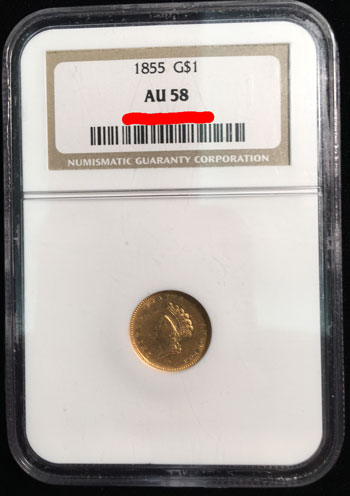
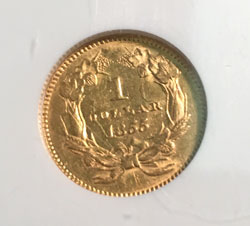
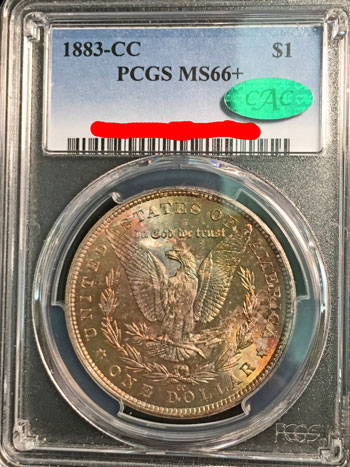
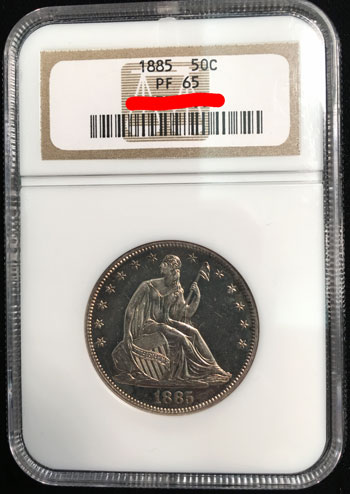
NGC graded the next coin, an 1885 Seated Liberty Half Dollar, as a PF-65 or Proof-65.
Back in the 1800s, the US Mint did not produce the quantity of proof coins that they do today.
For this particular coin, the Red Book shows just 930 proof coins produced at the Philadelphia mint.
NGC adds this commentary:
"The mintage for this issue represents the number of silver proof sets sold for 1885. This set consisted of three minor coins (cent, three cents, five cents) and four silver issues (dime, quarter, half and dollar).
"Proof half dollars were delivered in each of the year's four quarters: 450, 108, 60 and 320, respectively. This left eight odd pieces that were destroyed at the end of the calendar year.
"Only a single die marriage has been observed for this date, and it features a reverse die used on the last emission of 1884-dated halves.
Back in the 1800s, the US Mint did not produce the quantity of proof coins that they do today.
For this particular coin, the Red Book shows just 930 proof coins produced at the Philadelphia mint.
NGC adds this commentary:
"The mintage for this issue represents the number of silver proof sets sold for 1885. This set consisted of three minor coins (cent, three cents, five cents) and four silver issues (dime, quarter, half and dollar).
"Proof half dollars were delivered in each of the year's four quarters: 450, 108, 60 and 320, respectively. This left eight odd pieces that were destroyed at the end of the calendar year.
"Only a single die marriage has been observed for this date, and it features a reverse die used on the last emission of 1884-dated halves.
"While hardly common, enough gems survive of the 1885 proof half dollar to satisfy the demand from advanced collectors. A few dozen Cameo examples have been certified, along with an extremely small quantity of Ultra Cameo coins."
NGC has graded 293 of the proof coins, though this number may include double counting, with 41 of them as Proof-65.
In summary, this is a nice example of a 133-year-old proof silver half dollar designed by Christian Gobrecht and struck at the Philadelphia mint.
NGC has graded 293 of the proof coins, though this number may include double counting, with 41 of them as Proof-65.
In summary, this is a nice example of a 133-year-old proof silver half dollar designed by Christian Gobrecht and struck at the Philadelphia mint.
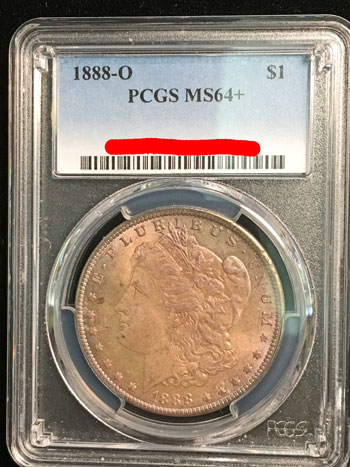
The next coin is another Morgan Dollar, this one from New Orleans in 1888.
For this coin, year and mint, PCGS CoinFacts includes detailed comments by Q. David Bowers regarding the quantities of these coins still available.
Some people agreed that many bags were found and distributed years later, in the 1940s, 50s and 60s.
Others did not think that many survived since they had difficulty finding bags of the silver dollars during those years they were supposedly released.
For now, at least, it appears the "many" perspective is the winning opinion.
PCGS estimates roughly 1.15 million of the coins survived in all conditions with 280,000 in MS-60 or better and 7,100 in MS-65 or better grades.
PCGS has graded just under 9000 as MS-64, and due to the quantities, this coin's value floats around the $100 mark.
It may not be scarce. It may not be terribly expensive, but it is a nice example of George Morgan's design.
For this coin, year and mint, PCGS CoinFacts includes detailed comments by Q. David Bowers regarding the quantities of these coins still available.
Some people agreed that many bags were found and distributed years later, in the 1940s, 50s and 60s.
Others did not think that many survived since they had difficulty finding bags of the silver dollars during those years they were supposedly released.
For now, at least, it appears the "many" perspective is the winning opinion.
PCGS estimates roughly 1.15 million of the coins survived in all conditions with 280,000 in MS-60 or better and 7,100 in MS-65 or better grades.
PCGS has graded just under 9000 as MS-64, and due to the quantities, this coin's value floats around the $100 mark.
It may not be scarce. It may not be terribly expensive, but it is a nice example of George Morgan's design.
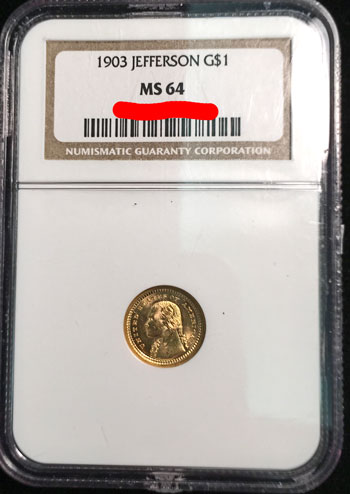
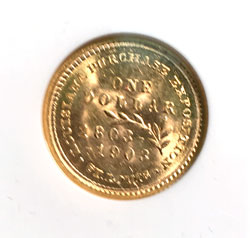
This coin represents the first gold commemorative authorized by Congress.
The coin became the keepsake commemorative to remember and recognize the 100th anniversary of the Louisiana Purchase.
The U. S. Mint produced two gold dollar coins, one with President Thomas Jefferson who was president when the Louisiana Territory was purchased from France in 1803.
The second gold dollar included a portrait of President McKinley who approved the exposition just six months before his assassination.
Both commemorative gold dollars have the same simple reverse, which shows ONE DOLLAR, the years 1803-1903, an olive branch and the inscription LOUISIANA PURCHASE EXPOSITION ST. LOUIS around the design.
Though the first gold commemorative, it was not the first commemorative coin. But, perhaps people were not ready to embrace the commemorative coin concept.
The coin became the keepsake commemorative to remember and recognize the 100th anniversary of the Louisiana Purchase.
The U. S. Mint produced two gold dollar coins, one with President Thomas Jefferson who was president when the Louisiana Territory was purchased from France in 1803.
The second gold dollar included a portrait of President McKinley who approved the exposition just six months before his assassination.
Both commemorative gold dollars have the same simple reverse, which shows ONE DOLLAR, the years 1803-1903, an olive branch and the inscription LOUISIANA PURCHASE EXPOSITION ST. LOUIS around the design.
Though the first gold commemorative, it was not the first commemorative coin. But, perhaps people were not ready to embrace the commemorative coin concept.
The Mint produced a combined total of 250,000 of the gold one dollar coins with their initial price at three dollars each.
Even after dropping the sales price, the Mint melted 215,000 of the gold coins just a few years later.
Each design, Jefferson vs. McKinley, shares equally in the number minted, since the Mint did not maintain detailed records by design.
Numismatists believe 10,000 of the Jefferson Louisiana Purchase Exposition gold dollar coins still exist across all grades.
For this MS-64 graded coin, NGC estimates its value in the low $1000s.
Over 200 years later, this coin remains a beautiful reminder that the country's land basically doubled with the purchase of the Louisiana Territory in 1803.
Even after dropping the sales price, the Mint melted 215,000 of the gold coins just a few years later.
Each design, Jefferson vs. McKinley, shares equally in the number minted, since the Mint did not maintain detailed records by design.
Numismatists believe 10,000 of the Jefferson Louisiana Purchase Exposition gold dollar coins still exist across all grades.
For this MS-64 graded coin, NGC estimates its value in the low $1000s.
Over 200 years later, this coin remains a beautiful reminder that the country's land basically doubled with the purchase of the Louisiana Territory in 1803.
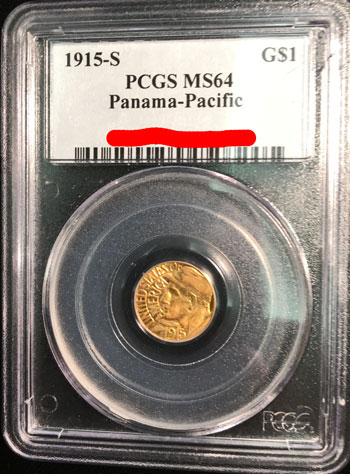
On August 15, 1914, the Panama Canal opened to ships moving between the Atlantic and Pacific oceans.
France began the construction of the canal in 1881, but stopped the project due to engineering problems and many worker deaths.
The United States took over the project in 1904, and ten years later opened the canal to shipping traffic.
In 1915, the Panama-Pacific International Exposition in San Francisco celebrated the opening of the new canal.
As part of the celebration, Congress approved several different coins, one of which was the Gold Dollar Coin.
Charles Keck, a well-known New York sculptor, accepted the challenge to design the one dollar gold coin.
France began the construction of the canal in 1881, but stopped the project due to engineering problems and many worker deaths.
The United States took over the project in 1904, and ten years later opened the canal to shipping traffic.
In 1915, the Panama-Pacific International Exposition in San Francisco celebrated the opening of the new canal.
As part of the celebration, Congress approved several different coins, one of which was the Gold Dollar Coin.
Charles Keck, a well-known New York sculptor, accepted the challenge to design the one dollar gold coin.
His first design portrayed Poseidon, Greek God of the Sea, on the coin's obverse, however the design was too detailed for such a small coin.
His final design, perhaps more fitting, showed the profile of a worker representing the many that helped complete the canal.
His reverse design did bring in components of the sea with two dolphins playing around the ONE DOLLAR in the middle of the coin.
The Red Book lists the total mintage at 15,000, and PCGS CoinFacts estimates 12,000 of those coins still exist across all grades with 10,000 in MS-60 and above.
For the MS-64, PCGS has graded 1,774 while NGC has graded 1,077.
With so many surviving, the two major grading companies estimate the value of the MS-64 between $750 and $850.
This coin is a small and interesting artifact celebrating the completion of a major engineering feat over 100 years ago.
His final design, perhaps more fitting, showed the profile of a worker representing the many that helped complete the canal.
His reverse design did bring in components of the sea with two dolphins playing around the ONE DOLLAR in the middle of the coin.
The Red Book lists the total mintage at 15,000, and PCGS CoinFacts estimates 12,000 of those coins still exist across all grades with 10,000 in MS-60 and above.
For the MS-64, PCGS has graded 1,774 while NGC has graded 1,077.
With so many surviving, the two major grading companies estimate the value of the MS-64 between $750 and $850.
This coin is a small and interesting artifact celebrating the completion of a major engineering feat over 100 years ago.
1915 Pan Pacific Gold $2.5
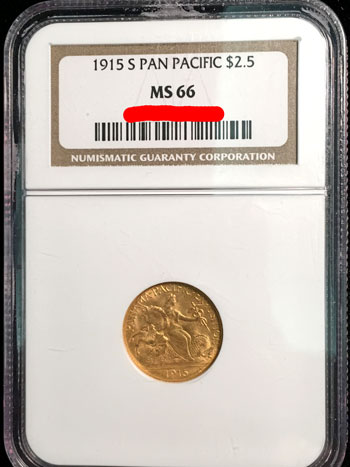
This next coin is another coin from the Panama-Pacific International Exposition. This time, the coin is a quarter eagle or $2.50 denomination.
The U.S. Mint determined Charles E. Barber and George T. Morgan, both Mint sculptors, would design the quarter eagle.
Barber produced the obverse design and Morgan the reverse.
One could look at all the "Barber" coins with his Liberty Head design and think the gentleman had little imagination.
But, that view is perhaps unfair since Congress dictated a lot of the coin devices; not the details, but the devices.
For the quarter eagle, Barber's obverse design shows Columbia with a caduceus in her left hand seated on a hippocampus to represent the use of the new canal.
The U.S. Mint determined Charles E. Barber and George T. Morgan, both Mint sculptors, would design the quarter eagle.
Barber produced the obverse design and Morgan the reverse.
One could look at all the "Barber" coins with his Liberty Head design and think the gentleman had little imagination.
But, that view is perhaps unfair since Congress dictated a lot of the coin devices; not the details, but the devices.
For the quarter eagle, Barber's obverse design shows Columbia with a caduceus in her left hand seated on a hippocampus to represent the use of the new canal.
A caduceus was the staff carried by Mercury as messenger of the gods, and a hippocampus was a sea horse with two forefeet, and a body ending in the tail of a dolphin or fish.
Of course, Columbia was frequently used to represent the United States.
For the reverse, Morgan designed a beautiful eagle with wings raised ready to fly.
Since the Expo was in San Francisco, all of the Pan-Pac coins were struck at the San Francisco Mint.
Congress specified the quarter eagle mintage to be 10,000 coins, however the 3,251 unsold coins were melted, leaving a population of just 6,749 coins.
Of course, Columbia was frequently used to represent the United States.
For the reverse, Morgan designed a beautiful eagle with wings raised ready to fly.
Since the Expo was in San Francisco, all of the Pan-Pac coins were struck at the San Francisco Mint.
Congress specified the quarter eagle mintage to be 10,000 coins, however the 3,251 unsold coins were melted, leaving a population of just 6,749 coins.
Today, PCGS CoinFacts estimates 4,500 of the coins remain with 3,800 of those in MS-60 or higher grades.
Both PCGS and NGC value the MS-66 Panama-Pacific International Exposition gold quarter eagle coin in the mid $6000s range.
With its shiny gold, this coin remains an interesting and beautiful example of the mint sculptors' creativity through the years.
Both PCGS and NGC value the MS-66 Panama-Pacific International Exposition gold quarter eagle coin in the mid $6000s range.
With its shiny gold, this coin remains an interesting and beautiful example of the mint sculptors' creativity through the years.
1926 Sesquicentennial Gold $2.5
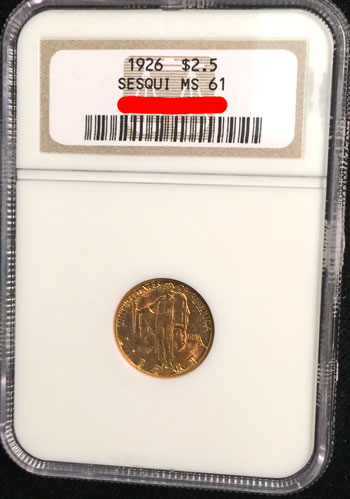
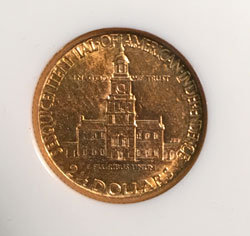
This coin, another gold commemorative quarter eagle, helped celebrate the sesquicentennial (150th) anniversary of the signing of the Declaration of Independence.
Though the National Sesquicentennial Exhibition Association wanted a series of commemorative coins, Congress approved two-the silver half dollar and the gold quarter eagle.
John Sinnock, the Chief Engraver-Sculptor of the U.S. Mint, designed both the obverse and the reverse of the gold quarter eagle.
For the obverse, he chose Liberty as the main focus with her standing upon the top of a globe. In her right hand, she holds the Torch of Freedom and in her left she holds a scroll representing the Declaration of Independence.
The main device on the reverse is a representation of Independence Hall where the men signed the historical document.
Though the National Sesquicentennial Exhibition Association wanted a series of commemorative coins, Congress approved two-the silver half dollar and the gold quarter eagle.
John Sinnock, the Chief Engraver-Sculptor of the U.S. Mint, designed both the obverse and the reverse of the gold quarter eagle.
For the obverse, he chose Liberty as the main focus with her standing upon the top of a globe. In her right hand, she holds the Torch of Freedom and in her left she holds a scroll representing the Declaration of Independence.
The main device on the reverse is a representation of Independence Hall where the men signed the historical document.
The Congressional approval allotted the Mint to produce up to 200,000 of the gold quarter eagle coins, however many were left unsold at the close of the Sesquicentennial Exhibition in Philadelphia.
The unsold coins returned to the Mint to be melted and re-used.
Records note people purchased 45,793 of the coins of which PCGS CoinFacts estimates 22,000 survive today.
Some coin historians believe people did not care for Sinnock's low relief design.
But, the estimates claim 15,000 of the remaining coins are in MS-60 or better grades.
The unsold coins returned to the Mint to be melted and re-used.
Records note people purchased 45,793 of the coins of which PCGS CoinFacts estimates 22,000 survive today.
Some coin historians believe people did not care for Sinnock's low relief design.
But, the estimates claim 15,000 of the remaining coins are in MS-60 or better grades.
Both PCGS and NGC show values for the MS-61 grade from the mid $400s to the mid $500s.
Our example, as an MS-61, shows some wear but still showcases Sinnock's Liberty and Independence Hall designs.
Our example, as an MS-61, shows some wear but still showcases Sinnock's Liberty and Independence Hall designs.
1941 Silver Half Dollar
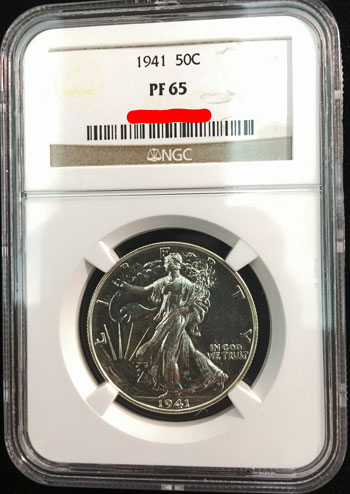
This coin showcases A. A. Weinman's Walking Liberty design first introduced in 1916.
Response to a Numismatic News survey in the 1990s showed this design as being the favorite coin design produced by the U.S. Mint.
Of course, the obverse design can also be seen on the American Silver Eagle coins.
Through the years of Walking Liberty half dollar coins, the Mint produced proof versions in only seven years, 1938 through 1942.
NGC graded this 1941 as a Proof-65; one of 15,412 proofs struck in that year.
Interestingly, the Red Book notes the total proof coins includes those with and without the designer's initials.
However, neither NGC nor PCGS comment on the designer's initials on their general information for the proof 1941 half dollar.
Response to a Numismatic News survey in the 1990s showed this design as being the favorite coin design produced by the U.S. Mint.
Of course, the obverse design can also be seen on the American Silver Eagle coins.
Through the years of Walking Liberty half dollar coins, the Mint produced proof versions in only seven years, 1938 through 1942.
NGC graded this 1941 as a Proof-65; one of 15,412 proofs struck in that year.
Interestingly, the Red Book notes the total proof coins includes those with and without the designer's initials.
However, neither NGC nor PCGS comment on the designer's initials on their general information for the proof 1941 half dollar.
Within their VarietyPlus tool, NGC does identify the no "AW" proof coin with this commentary:
"Diagnostics - Polishing of the die to remove clash marks or erosion lines obliterated the designer's monogram. This is more correctly known as a die state, rather than a true variety."
When included, the initials AW, with one letter over the other, can be found on the reverse at the end of the limb and just below the eagle's tail feathers.
For their example 1941 proof coins, both companies show the 1941 proof half dollar with a reverse that does not include the designer's initials.
Since they do not readily specify a difference, perhaps there is not a significant premium applied to either version.
PCGS CoinFacts estimates the survival of the 1941 proof half dollar at 13,250 with 7,250 at Proof-65 or higher grades.
The companies value the PR-65 1941 half dollar in the range of upper $400s to upper $500s.
She's just another beautiful coin showing "Liberty walking into the dawn of a new day" as Mr. Weinman described his design over 100 years ago.
"Diagnostics - Polishing of the die to remove clash marks or erosion lines obliterated the designer's monogram. This is more correctly known as a die state, rather than a true variety."
When included, the initials AW, with one letter over the other, can be found on the reverse at the end of the limb and just below the eagle's tail feathers.
For their example 1941 proof coins, both companies show the 1941 proof half dollar with a reverse that does not include the designer's initials.
Since they do not readily specify a difference, perhaps there is not a significant premium applied to either version.
PCGS CoinFacts estimates the survival of the 1941 proof half dollar at 13,250 with 7,250 at Proof-65 or higher grades.
The companies value the PR-65 1941 half dollar in the range of upper $400s to upper $500s.
She's just another beautiful coin showing "Liberty walking into the dawn of a new day" as Mr. Weinman described his design over 100 years ago.
That concludes our virtual tour of the August bourse.
Of course, these few coins are but a small example of what the dealers display in their showcases each month.
Our dealers represent a broad range of collectible interests, not just coins, and their displays change from month-to-month.
Dealers are collectors too. They may have a primary interest, but most will have many secondary interests in their displays as well.
Visitors can find coins from the ancient to the modern and from domestic to foreign along with currency, old and modern.
Many dealers also offer bullion from silver to gold to platinum to palladium with some domestic and some foreign in their showcases.
There are other money-related collectibles such as scrip, stock certificates, letters and other paper collectibles.
And, if the dealers find something that interests them that is not coin related, they display those items too.
Each month, the dealers' change their showcases based on what they've found and what they think may pique the visitors' interests.
Mark your calendars for the next Greater Atlanta Coin Show on Sunday, September 9, 2018, in the Joe Mack Wilson ballroom on the main conference area.
Of course, these few coins are but a small example of what the dealers display in their showcases each month.
Our dealers represent a broad range of collectible interests, not just coins, and their displays change from month-to-month.
Dealers are collectors too. They may have a primary interest, but most will have many secondary interests in their displays as well.
Visitors can find coins from the ancient to the modern and from domestic to foreign along with currency, old and modern.
Many dealers also offer bullion from silver to gold to platinum to palladium with some domestic and some foreign in their showcases.
There are other money-related collectibles such as scrip, stock certificates, letters and other paper collectibles.
And, if the dealers find something that interests them that is not coin related, they display those items too.
Each month, the dealers' change their showcases based on what they've found and what they think may pique the visitors' interests.
Mark your calendars for the next Greater Atlanta Coin Show on Sunday, September 9, 2018, in the Joe Mack Wilson ballroom on the main conference area.
However, the southern branch mints used old equipment discarded from Philadelphia. These old presses generated coins poorly struck with weak features that became easily worn.
As a result, many of these coins were melted by the Mint and the gold reused in other coins. Also, due to their size, many of these coins were lost.
This coin was one of the 758,269 stronger specimens struck by the Philadelphia mint.
Of those, NGC has graded 5438 with 2023 of them as AU-58 and 1522 in grades higher.
Oddly, looking at the Professional Coin Grading Service (PCGS) CoinFacts, they have graded 3925 and estimate a survival rate of roughly 5000 of the 1855 Gold Dollar coins minted in Philadelphia.
Now, the grading counts do include duplicates where people cracked the coins out of their certified holders and resubmitted them hoping for a higher grade.
As a result, many of these coins were melted by the Mint and the gold reused in other coins. Also, due to their size, many of these coins were lost.
This coin was one of the 758,269 stronger specimens struck by the Philadelphia mint.
Of those, NGC has graded 5438 with 2023 of them as AU-58 and 1522 in grades higher.
Oddly, looking at the Professional Coin Grading Service (PCGS) CoinFacts, they have graded 3925 and estimate a survival rate of roughly 5000 of the 1855 Gold Dollar coins minted in Philadelphia.
Now, the grading counts do include duplicates where people cracked the coins out of their certified holders and resubmitted them hoping for a higher grade.

